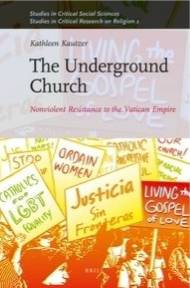
The book provides a rare and comprehensive examination of liberal and radical Catholic groups and movements in the U.S. The book is based on extensive fieldwork among such reformist groups as Corpus (consisting of former priests), Dignity (gay Catholics), Women’s Ordination Conference (WOC), and Voice of the Faithful (a group that formed over the priest sex abuse crisis in the American church), as well as more radical groups that have made a complete break with the church (such as schismatic parishes and some feminist groups).
In tracing the histories of these groups, Kautzer notes how they have gradually evolved from optimistic efforts of reform of the church based on a liberal interpretation and appropriation of Vatican II to a far more contentious and eventually pessimistic stance regarding the possibility of significant change in the church. Of course, the level of demands for liberal reform vary with each group. The author shows that the Voice of the Faithful (VOTF), the most moderate of the groups she studied, was able to exert pressure on dioceses and other church structures to make some policy changes, at least on the pressing issue of clergy sex abuse.
The abuse issue had given the reform movement a “second wind,” but groups such VOTF were “dealt a fatal blow,” when Pope Benedict XVI became more active in addressing issues related to the crisis and meeting with victims. In other words, the issue that had galvanized reform groups (and given them a good deal of publicity) was co-opted by the mainstream church, making their activism less necessary.
Kautzer adds that “Many reformers have grown weary of the fruitless battle with church hierarchs, who increasingly respond to reformers with harsh rhetoric and punitive measures.” She documents a broad decline in membership and resources for most of the reform groups. Reformers often “privately acknowledge that the contemporary wave of the reform movement may fade in a decade or less, given the graying of the movement and the widespread apathy regarding church reform among most sectors of the laity, especially young Catholics.”
There is also a measure of tension and divisions within these groups, with the least liberal members favoring strategies that are deferential to church hierarchs “while the more left-leaning members favor confrontational strategies,” Kautzer writes. While what she calls “insider strategies” of reform, stressing working from within the church, have proven ineffective, “outsider strategies” are becoming more popular, particularly with feminist groups such as the Women’s Ordination Conference (WOC). These groups stage protests, exert external pressure (often through the media), and start alternative communities.
It is these independent communities that are drawing liberal Catholics who are pessimistic about change in the church on such issues as ordaining women priests, acceptance of gays and lesbians, and lifting the requirement of celibacy for priests. These organizations include Roman Catholic Womanpriests, which functions as a seminary for women priests; new networks of independent Catholic parishes including the Ecumenical Catholic Communion (ECC), and the Catholic Diocese of One Spirit.
These groups act as separate denominations, although in the case of the ECC, they are connected to long-time schismatic movements such as the Old Catholics. They conduct unauthorized ordinations and eucharists, even though many of its members still consider themselves Roman Catholics. While some independent groups, such as the ECC, show growth, others tend to have graying memberships and have difficulty sustaining themselves financially, according to Kautzer.
Richard Cimino
Richard Cimino is the founder and editor of Religion Watch, a newsletter monitoring trends in contemporary religion. Since January 2008, Religion Watch is published by Religioscope Institute. Website: www.religionwatch.com.